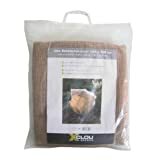Climbing roses can enhance any garden with their overwhelming abundance of flowers. But it requires the right care for the climbing roses to bloom so richly.

roses (pink) have been extremely popular flowers for ages. When caring for your climbing roses, the main focus is not on fertilizing and watering, but on tying up and cutting. Despite the name, the plants do not climb and twist on their own. They have no classic holding organs, but belong to the spread clamps. So that the growth works up and as many flowers as possible are formed, a lot of help has to be given.
contents
- Water climbing roses properly
- Fertilize climbing roses: how and how often?
- Pruning climbing roses and keeping them in shape
- Climbing roses overwinter
Water climbing roses properly
The first contact with water occurs even before planting. Water the rose for several hours before planting to avoid drought stress later. Watering is even more frequent during the growing season. Once the long roots have penetrated the soil, it only needs to be watered after longer periods of drought. You then water the plants in the morning or evening, but never in the blazing midday sun. Watering is also done from below, which reduces the likelihood of fungal attack on the leaves. The soil may have compacted after a heavy rainfall or a generous dose of watering. Do your climbing roses a favor by gently loosening the soil. This way more air gets to the roots.

Fertilize climbing roses: how and how often?
Freshly planted climbing roses are fertilized after the first flowering when they are properly established. Once the plant has established itself in the garden, it is fertilized once at the beginning of April and a second time at the end of June after flowering. The soil around the roots is loosened and the fertilizer is carefully worked in. Later in the year, fertilization is stopped to allow newly formed shoots to mature before winter. Do not use mineral fertilizers, especially with freshly planted climbing roses, but organic variants. Synthetic fertilizer is made from minerals that have been more or less chemically modified. Manufacturing is resource-intensive and the rapid release of nutrients can lead to over-fertilization and susceptibility to disease. Therefore, it is better to switch to organic fertilizers straight away. Since roses with their impressive flowers consume an incredible amount of nutrients, there are special rose fertilizers that are adapted to the needs of the elegant plants. Such a fertilizer for roses is also ours Plantura organic rose fertilizer with long-term effect. This provides your climbing roses with all the important nutrients and is also kind to the environment.
Pruning climbing roses and keeping them in shape
Since climbing roses do not grow into the desired shape by pure mental power, the queen of flowers must be pruned regularly and her growth steered in the right direction. Therefore, your climbing rose needs to be shaped. Here you pull new shoots regularly on the climbing aid. Depending on the trellis, the shoots are placed around the framework in a spiral, fan shape or crosswise. The shoots are loosely attached with raffia, plant chips or rubber-coated wire. When shaping, the following applies: the more horizontally the plant grows afterwards, the more flowers can be admired later. If the colorful climbers simply grow straight up to the sky, the lower area will be bare because the flowers only form at the top.
When to cut climbing roses
But shapes alone do not make an impressive blooming rose arch. Proper pruning is particularly important for multi-flowering varieties for flowering shoots and a healthy plant. The side shoots are shortened to two to five eyes. The cut is made at an angle and is made about five millimeters above an outward-growing bud. This should be done once a year to encourage branching and flowering. When to prune depends on how often the rose variety blooms in the year.
- Spring (climbing roses that bloom more often): cut back side shoots; Remove 1-2 main shoots per year; Remove winter damage
- Autumn (climbing roses that bloom once): Clean after flowering and only cut back side shoots if necessary

The spring pruning takes place only when there is no longer any danger of frost. You can use the forsythia as a guide. Because if the yellow flowers sprout in the garden, you can dare to cut them in spring. When pruning in the fall, make sure you only cut away what is absolutely necessary. If the plant gets frost in winter, there won't be much else left in spring. After cutting back, the remaining shoots are pulled over the climbing aid and fastened.
But not only an annual pruning is important. Regularly cleaning out wilted flowers also promotes long flowering. In addition, wild shoots of the wild rose root are removed. This prevents them from overgrowing the hybrid tea.
notice: Bare root roses should be cut back to about 50 cm before planting.
Climbing roses overwinter
Earth is piled at the base of the climbing rose to protect it from cold weather and dehydration in the fall. In addition, you can set up a willow mat to protect the lower two meters. The rose is wrapped with it and is thus protected from wind and sun. Shoots that tower above the whole are covered with burlap. With hardy varieties such as 'Amadeus' or 'Laguna' you can do without the additional protection. Conditionally hardy varieties such as 'Rosanna' or 'Aloha' insist on extra protection.
These products protect your plants from frost:- Thermal garden fleece: Optimal to protect your plants from cold and frost in winter. Can be cut individually.
- Jute sack/blanket: Reliable protection against cold and frost made from 100% jute. Decorative natural fabric with a long service life.
- coconut mat: Excellent thermal retention made of natural fiber. Breathable, weather-resistant and durable.

Garden fleece, frost protection, growth-promoting microclimate
4,49€
Details →

Jute protective fleece made of 100% jute fibers, approx. 105x500cm
11,03€11,01€
Details →
- 30%

Coconut felt mat, cold protection 0.5 x 1.5 m, brown,
9,99€6,95€
Details →



